![]()
![]()
![]()
Use LEFT and RIGHT arrow keys to navigate between flashcards;
Use UP and DOWN arrow keys to flip the card;
H to show hint;
A reads text to speech;
34 Cards in this Set
- Front
- Back
|
Heart is a remarkable organ.. 1. Beating? 2. Pumping? |
1.Beating more than 40 million times a year 2. Pumping over 7500 liters of blood a day. |
|
|
...... is the first organ to become fully functional in utero. When? |
The cardiovascular system, at approximately 8 weeks of gestation. |
|
|
Define congenital heart disease |
Congenital heart disease is a general term used to describe abnormalities of the heart or great vessels that are present from birth. |
|
|
Most congenital heart disease arise from? |
Most such disorders arise from faulty embryogenesis during gestational weeks 3 through 8, when major cardiovascular structures form and begin to function. |
|
|
Etiology / pathogenesis of congenital heart disease |
The cause is unknown in almost 90% cases . The known etiologic factors, environmental causes including 1. Congenital rubella infection 2. Teratogens 3. Maternal diabetes 4. Genetic factors .... The most common genetic genetic cause - is trisomy 21 i.e downs syndrome. |
|
|
The most common genetic cause of congenital heart disease is |
Trisomy 21 ( down syndrome) , in which about 40% of patients have one or more heart defects. |
|
|
Classification of congenital heart disease |
1. Left to right shunts 2. Right to left shunts 3. Obstruction
A. LEFT-TO-RIGHT SHUNT : EG i.Atrial septal defect (ASD) ii.Ventricular septal defect (VSD) iii.Patent ductus arteriosus(PDA) iv. Atrioventricular septal defect(AVSD) B. RIGHT-TO-LEFT SHUNT : EG i.Tetralogy of fallot (TOF) ii.Transposition of great vessels (TGV) iii.Tricuspid atresia (TA) iv.Total anomalous pulmonary venous connections (TAPVC) v.Truncus arteriosus C. OBSTRUCTION. i. Pulmonary stenosis and atresia ii. Aortic stenosis and atresia iii. Coarctation of aorta |
|
|
........ is the most common type of congenital heart disease |
Left to right shunts. Esp VSD Which are - A. LEFT-TO-RIGHT SHUNT : EG i.Atrial septal defect (ASD) ii.Ventricular septal defect (VSD) iii.Patent ductus arteriosus(PDA) iv. Atrioventricular septal defect(AVSD) |
|
|
.....1.. Typically increase only right ventricular and pulmonary outflow volumes, While...2.... & ...3.. cause both increased pulmonary blood flows and pressure |
1. ASD 2. VSD 3. PDA |
|
|
....... Is not an early feature of left to right shunts |
Cynosis |
|
|
Cynosis, pulmonary hypertension, eisenmenger syndrome and left to right shunts |
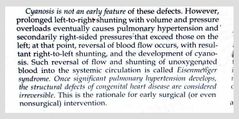
|
|
|
ASD Vs patent foramen ovale |
In contrast to patent foramen ovale, an ASD is an abnormal fixed opening in the atrial septum that allows unrestricted blood flow between the atrial chambers. A majority of ASD ( 90%) are so called ostium secondum defects in which growth of the septum secondum is insufficient to occlude the second ostium. |
|
|
Morphology of ASD |
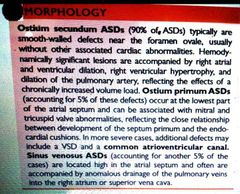
|
|
|
Over time ASD can lead to |
1. Right to left shunt 2. HF 3. Paradoxical embolization 4. Irreversible pulmonary vascular disease |
|
|
The ventricular septum normally is formed by |
The fusion of a muscular ridge that grows upward from the apex of the heart to a thinner membraneous partition that grows downwards from the endocardial cushions. The basal ( membraneous) region is the last part of the septum to develop and is the site of approximately 90% of VSD . |
|
|
About VSD |
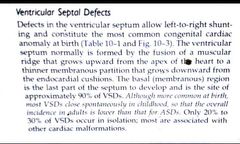
|
|
|
VSD - the........ Region is the last part of the septum to develop and is the site of approximately ...... % of VSD |
Basal ( membraneous) region, 90% |
|
|
ductus arteriosus arises from? |
From the left pulmonary artery and joins the aorta just distal to the origin of the left subclavian artery |
|
|
Two of the most important conditions associated with cyanotic congenital heart disease are? List others |
i.Tetralogy of fallot (TOF) ii.Transposition of great vessels (TGV) Others; iii.Tricuspid atresia (TA) iv.Total anomalous pulmonary venous connections (TAPVC) v.Truncus arteriosus |
|
|
Discuss AVSD |
Atrioventricular septal defect(AVSD): Embryologic failure of the superior and inferior endocardial cushions of the AV canal to fuse adequately leading to incomplete closure of the AV septum and malformation of the tricuspid and mitral valves. 1. Partial AVSD :consisting of a primum ASD and a cleft anterior mitral leaflet. 2. Complete AVSD:consisting of a large combined AV septal defect and a large common AV valve |
|
|
Partial Vs complete AVSD |
1. Partial AVSD :consisting of a primum ASD and a cleft anterior mitral leaflet. 2. Complete AVSD:consisting of a large combined AV septal defect and a large common AV valve |
|
|
About tetralogy of fallot - 1. List four cardinal features 2. Pathology 3. Morphology 4. Clinical features |
1.Tetralogy of fallot (TOF): The four cardinal features of the tetralogy of Fallot 1.VSD, (2) obstruction of the right ventricular outflow tract (subpulmonary stenosis), (3) An aorta that overrides the VSD,(4)Right ventricular hypertrophy.
2. All of the features of tetralogy of Fallot result from anterosuperior displacement of the infundibular septum leading to abnormal septation between the pulmonary trunk and the aortic root. 3. Morphology - the heart is enlarged and boot shaped 👢
4. The clinical consequences depend primarily on the severity of the subpulmonary stenosis, as this determines the direction of blood flow. Classical and mild type. 5. Clinical FeaturesThe hemodynamic consequences of tetralogy of Fallotare 1. right-to-left shunting, 2. decreased pulmonary bloodflow, and 3. increased aortic volumes.
|
|
|
Discuss transposition of the great arteries 1. Definition 2. Pathology 3. Dorminat presentation |
1.Transposition of the great arteries is a discordant connection of the ventricles to their vascular outflow. 2. The Enbryologic defect is an abnormal formation of the truncal and aortopulmonary septa so that the aorta arises from the right ventricle and the pulmonary artery emanates from the left ventricle.The atrium-to-ventricle connections, however, are normal (concordant), with the right atrium joining the right ventricle and the left atrium emptying into the left ventricle.The functional outcome is separation of the systemic and pulmonary circulations, a condition incompatible with postnatal life unless a shunt (such as a VSD) allows delivery of oxygenated blood to the aorta. 3. Dorminat presentation is cynosis |
|
|
About triscupid atresia |
1. Tricuspid atresia (TA): Unequal division of the AV canal. Mitral valve is larger than normal, and there is almost always underdevelopment (hypoplasia) of the right ventricle. Circulation is maintained by a right-to-left shunt through an ASD or patent foramen ovale and a VSD. |
|
|
About patent truncus arteriosus |
Patent truncus arteriosus: There is Developmental failure of separation of the embryologic truncus arteriosus into the aorta and pulmonary artery . This results in a single great artery that receives blood from both ventricles and gives rise to the systemic, pulmonary, and coronary circulations. |
|
|
About total anomalous pulmonary venous connections |
Total anomalous pulmonary venous connections (TAPVC): Pulmonary veins fail to directly join the left atrium. This results when the common pulmonary vein fails to develop or becomes atretic. Either a patent foramen ovale or an ASD is always present. Consequences of TAPVC include 1.volume and pressure hypertrophy and 2. dilation of the right side of the heart, and 3. dilation of the pulmonary trunk. |
|
|
About coarctation of the aorta 1. Define 2. Classic forms |

1. Coarctation of the Aorta: i. infantile form(Coarctation of the Aorta with PDA): has tubular hypoplasia of the aortic arch proximal to a patent ductus arteriosus that is often symptomatic in early childhood. ii. an adult form (Coarctation of the Aorta without PDA) - there is a discrete ridgelike infolding of the aorta, just opposite the closed ductus arteriosus (ligamentum arteriosum) distal to the arch vessels. 3. Morphology |
|
|
CONGENITAL HEART DISEASES DUE TO OBSTRUCTION . About pulmonary stenosis and atresia |
Pulmonary Stenosis and Atresia: When the valve is entirely atretic, there is no communication between the right ventricle and lungs. In such cases the anomaly is associated with a hypoplastic right ventricle and an ASD; blood also reaches the lungs through a patent ductus arteriosus.Mild stenosis may be asymptomatic & compatible with long life, whereas symptomatic cases require surgical correction. |
|
|
CONGENITAL HEART DISEASES DUE TO OBSTRUCTION About aortic stenosis and atresia |
3. Aortic Stenosis and Atresia: Congenital narrowing and obstruction of the aortic valve can occur at three locations: valvular, subvalvular, and supravalvular. |
|
|
CLINICAL FEATURES Of each type of congenital heart disease |
A. LEFT-TO-RIGHT SHUNT i.Features of RVF ii. Eisenmenger syndrome( Late cyanotic congenital heart dx) B. RIGHT-TO-LEFT SHUNT i.Cyanosis ii.Clubbing of tip of fingers and toes. iii. Polycythemia C. Clinical features of Obstructive type of CHD: i.Asymptomatic if mild ii.Symptomatic if severe iii.Systolic murmurs iv.Thrills – occur sometimes |
|
|
Morphology of ASD |
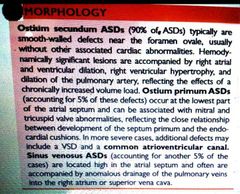
|
|
|
About patent ductus arteriosus |
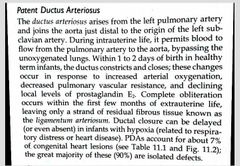
|
|
|
Clinical features of patent ductus arteriosus |
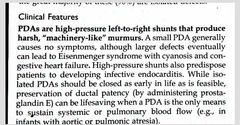
|
|
|
Intro to right to left shunts |
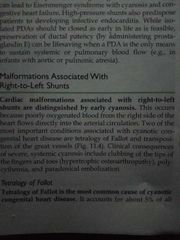
|

